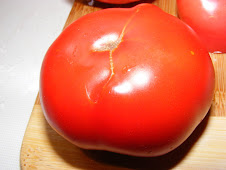I worry about what I post sometimes. I wonder if I am being clear enough, if I post too many pictures, or if I'm too wordy, and don't post enough pictures. Looking at other gardening blogs that I like to read, I realized the pictures are half the post. And the pictures make the post.
So I took pictures of my seeding process, step by step, in the hopes that it will clarify anything that I unwittingly omit. For many, this is old hat.
A while ago, a bunch of parents, at a playgroup that my daughter and I frequent, were discussing general gardening and gardening with kids, and as the admitted gardening junkie, they asked my opinions and ideas on a few things. (At least that's my story!!) One of my recommendations was to grow beans and peas with kids, because they can actually see the germination process in action. One of my friends asked about bean seeds. Well, I have a variety of beans at home, so I offered to bring some in for her. No, no, she said, I want to try the seeds. Uhm, bean seeds?? The beans are the seed, I told her. Ooohhh!!! You could see the comprehension dawning on her face. She doesn't garden much! I am not making fun of her, I am only trying to point out (in a humorous way) the disconnect many people have between their food, and the production of said food. I am sure she is not the only one.
Preparation:

I have my bucket of soil mix, my tray, my seed packets and my trusty notebook.
The next step is to fill up the trays, with the mix. I do not pre-moisten, I put it in dry, and lightly water once they are filled up.

Now I carefully place one seed in the middle of each cell. If you have older seed, you may want to use two or three seeds, just in case one doesn't germinate. If you have a limited amount of seed, one will do. Any cells that don't have a seedling germinate, you can always replant with a new seed in a week or so.

That little white round thing in the middle is a tomato seed.
Now I take about a third of a tablespoon of mix, and sprinkle it over the whole area so it just covers the seed.

 Then I use my trusty spray bottle to moisten that top sprinkling of soil, which ensures the seed comes in contact with the water and the soil and doesn't get moved around too much .
Then I use my trusty spray bottle to moisten that top sprinkling of soil, which ensures the seed comes in contact with the water and the soil and doesn't get moved around too much . I label each section as I go, or if I'm doing a hodge podge of different tomatoes, each cell. Sound simplistic, but you wouldn't believe how easy it is to forget what you just planted, especially if you are planning three steps ahead.
I label each section as I go, or if I'm doing a hodge podge of different tomatoes, each cell. Sound simplistic, but you wouldn't believe how easy it is to forget what you just planted, especially if you are planning three steps ahead.I use popsickle sticks or coffee stir sticks, broken in half to write in the variety. I also make a note in my little notebook, just in case.

Now it's ready for the dome lid, onto the shelf, and wait for the seedlings to pop out.

This is what you are hoping for in a few weeks or so:

Notice the lower baby leaves (the cotyledons, not true leaves) are yellowing a bit. These plants are in need of transplanting into a 4 inch pot, and a shot of fertilizer. The roots are growing right out of these peat pellets. They aren't too leggy though, because they have been up high in my window, getting lots of sun. So they are still looking pretty good. I will transplant soon, and give them a shot of Muskie (fish emulsion fertilizer) a few days or a week after transplanting. When I do transplant, I will plant them deep, stripping off the cotyledons if they have not already fallen off, and planting up to the first set of true leaves.
Here is a pic of an eggplant seedling, clearly showing the cotyledons, and the very beginning of the first true leaves.

Here is a picture of some eggplant seedlings, that have recently germinated. They are much slower than tomatoes. In fact, they were started the same day the above tomatoes were started. Notice too how they are curving to one side. This is photo tropism, the seedlings grow towards the light. I simply flip the trays around, and they start growing the other way.

Once the tomato seeds have germinated, I will remove the dome cover. I tend to keep my seedlings on the cooler side, which slows down growth, but indoors, that is what I want. I haven't yet set up my lights, but will have to do so shortly. It doesn't take long for tomatoes to germinate, and as soon as they do, you want to have them under as mush intense light for as long as possible. I will post a pic of my set up as soon as I get it going.
This is my little pre-Christmas Galina's Yellow experiment. She is doing very well. Notice how thick the stem is, and all the side shoots. I probably should give her a trim. But a pretty happy little tomato plant.


Galina's flowers mean I may get a little tomato sometime in the near future. Here's hoping!

No comments:
Post a Comment